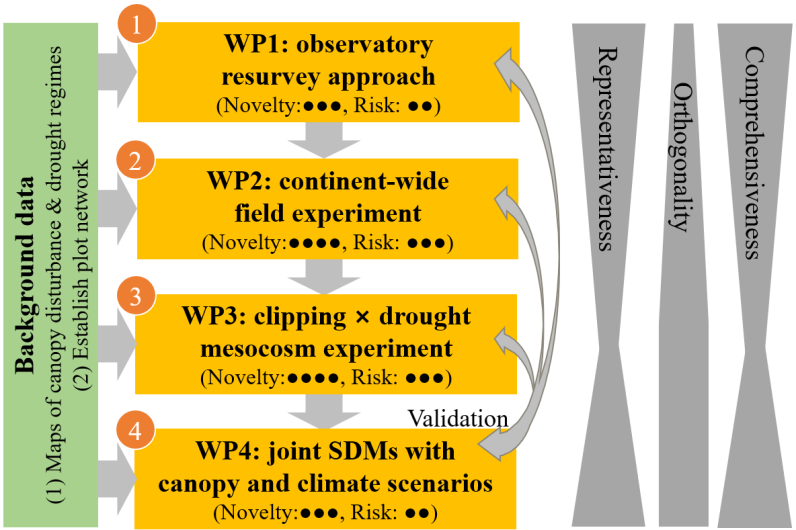About
The overarching aim of CanopyChange is to understand, quantify, and predict the (interactive) impacts of novel light regimes and drought on below-canopy forest plant biodiversity. To address this overarching aim and based on the state-of-the-art, four key hypotheses are formulated which will be addressed via the four multidisciplinary and complementary work packages (WPs).

Hypothesis 1
Focuses on the main effects of light and drought. No-analog light regimes result in strong understorey plant community reordering. The enhanced frequencies of extreme droughts are negatively impacting understorey plant performance and diversity. Since forest understoreys are often light limited, enhanced irradiance can strongly affect understorey processes and biodiversity. When the canopy is opened up, generalists, competitive forbs, ferns and grasses strongly increase in cover at the expense of typical closed-forest species and tree regeneration. Due to the influx of generalists, total understorey richness is expected to be higher under high light, but drought leads to declines.
Hypothesis 2
Focuses on interactive effects of light and drought. The effects of canopy disturbance and drought on plant biodiversity are strongly interactive, to the extent that the effects of one driver cannot be understood without also accounting for the other. When forest canopy opening and drought is induced, significant interactions will emerge. Because below-canopy microclimates are buffered in dense forests, drought impacts are expected to be less severe below undisturbed canopies. The strongest understorey drought impacts are expected in cases where the canopy is disturbed heavily and least when there is no/less disturbance or more shade. In those cases, drought results in performance and abundance declines of species adapted to moist, cool below-canopy conditions.
Hypothesis 3
Focuses on tipping points. We identify tipping points of canopy opening, beyond which understorey plant biodiversity and performance strongly declines under drought. Understoreys respond mostly to droughts when canopies are disturbed above a certain tipping point of canopy opening beyond which large and perhaps irreversible changes take place. Understorey plants thus do not respond, or less, to drought when canopy opening stays below this tipping point. Knowledge of these tipping points is key to inform forest and biodiversity management and policy.
Hypothesis 4
Focuses on the future and implications. Accounting for canopy structural changes improves our ability to predict forest plant biodiversity responses to future climate change. Including canopy disturbances and no-analog light regimes in predictions of forest biodiversity responses to climate change is essential. Better predictions of forest biodiversity, and community and range shifts in response to drought plus canopy change are urgently needed to inform forest and biodiversity management and policy.